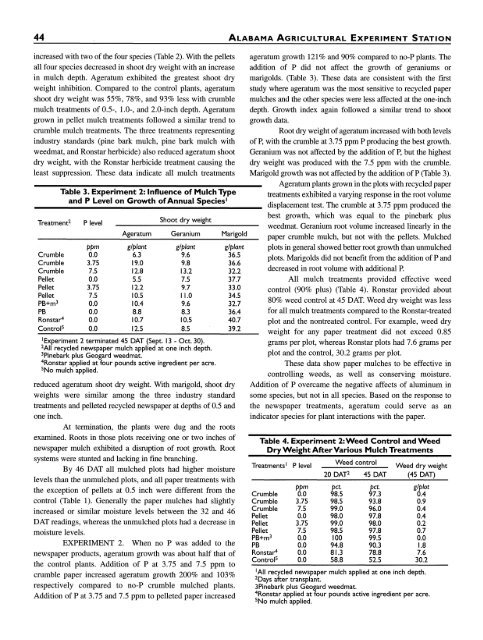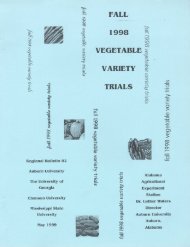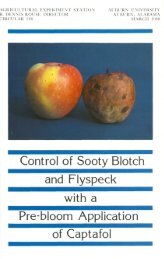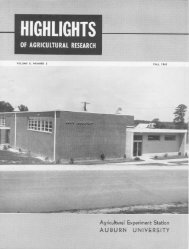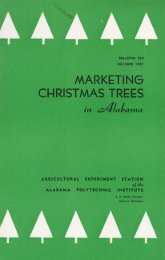1997 Ornamentals Research Report - AUrora - Auburn University
1997 Ornamentals Research Report - AUrora - Auburn University
1997 Ornamentals Research Report - AUrora - Auburn University
You also want an ePaper? Increase the reach of your titles
YUMPU automatically turns print PDFs into web optimized ePapers that Google loves.
44<br />
ALABAMA AGRICULTURAL EXPERIMENT STATION<br />
increased with two of the four species (Table 2). With the pellets<br />
all four species decreased in shoot dry weight with an increase<br />
in mulch depth. Ageratum exhibited the greatest shoot dry<br />
weight inhibition. Compared to the control plants, ageratum<br />
shoot dry weight was 55%, 78%, and 93% less with crumble<br />
mulch treatments of 0.5-, 1.0-, and 2.0-inch depth. Ageratum<br />
grown in pellet mulch treatments followed a similar trend to<br />
crumble mulch treatments. The three treatments representing<br />
industry standards (pine bark mulch, pine bark mulch with<br />
weedmat, and Ronstar herbicide) also reduced ageratum shoot<br />
dry weight, with the Ronstar herbicide treatment causing the<br />
least suppression. These data indicate all mulch treatments<br />
Table 3. Experiment 2: Influence of Mulch Type<br />
and P Level on Growth of Annual Species'<br />
Treatment 2 P level<br />
Ageratum<br />
Shoot dry weight<br />
Geranium Marigold<br />
Crumble<br />
Crumble<br />
Crumble<br />
Pellet<br />
Pellet<br />
Pellet<br />
PB+m<br />
ppm<br />
0.0<br />
3.75<br />
7.5<br />
0.0<br />
3.75<br />
7.5<br />
g/plant<br />
6.3<br />
19.0<br />
12.8<br />
5.5<br />
12.2<br />
10.5<br />
g/plant<br />
9.6<br />
9.8<br />
13.2<br />
7.5<br />
9.7<br />
I11.0<br />
g/plant<br />
36.5<br />
36.6<br />
32.2<br />
37.7<br />
33.0<br />
34.5<br />
3 PB<br />
Ronstar<br />
0.0<br />
0.0<br />
10.4<br />
8.8<br />
9.6<br />
8.3<br />
32.7<br />
36.4<br />
4 Control<br />
0.0 10.7 10.5 40.7<br />
s 44 ALABAMAAGRICULTURAL EXPERIMENT STATION<br />
ageratum growth 121% and 90% compared to no-P plants. The<br />
addition of P did not affect the growth of geraniums or<br />
marigolds. (Table 3). These data are consistent with the first<br />
study where ageratum was the most sensitive to recycled paper<br />
mulches and the other species were less affected at the one-inch<br />
depth. Growth index again followed a similar trend to shoot<br />
growth data.<br />
Root dry weight of ageratum increased with both levels<br />
of P, with the crumble at 3.75 ppm P producing the best growth.<br />
Geranium was not affected by the addition of P, but the highest<br />
dry weight was produced with the 7.5 ppm with the crumble.<br />
Marigold growth was not affected by the addition of P (Table 3).<br />
Ageratum plants grown in the plots with recycled paper<br />
treatments exhibited a varying response in the root volume<br />
displacement test. The crumble at 3.75 ppm produced the<br />
best growth, which was equal to the pinebark plus<br />
weedmat. Geranium root volume increased linearly in the<br />
paper crumble mulch, but not with the pellets. Mulched<br />
0.0 12.5 8.5 39.2<br />
plots in general showed better root growth than unmulched<br />
plots. Marigolds did not benefit from the addition of P and<br />
decreased in root volume with additional P.<br />
All mulch treatments provided effective weed<br />
control (90% plus) (Table 4). Ronstar provided about<br />
80% weed control at 45 DAT. Weed dry weight was less<br />
for all mulch treatments compared to the Ronstar-treated<br />
plot and the nontreated control. For example, weed dry<br />
weight for any paper treatment did not exceed 0.85<br />
2'Experiment 2 terminated 45 DAT (Sept. 13 - Oct. 30).<br />
All recycled newspaper mulch applied at one inch depth.<br />
3Pinebark plus Geogard weedmat.<br />
4Ronstar applied at four pounds active ingredient per acre.<br />
5No mulch applied.<br />
grams per plot, whereas Ronstar plots had 7.6 grams per<br />
plot and the control, 30.2 grams per plot.<br />
These data show paper mulches to be effective in<br />
controlling weeds, as well as conserving moisture.<br />
Addition of P overcame the negative affects of aluminum in<br />
some species, but not in all species. Based on the response to<br />
the newspaper treatments, ageratum could serve as an<br />
indicator species for plant interactions with the paper.<br />
reduced ageratum shoot dry weight. With marigold, shoot dry<br />
weights were similar among the three industry standard<br />
treatments and pelleted recycled newspaper at depths of 0.5 and<br />
one inch.<br />
At termination, the plants were dug and the roots<br />
examined. Roots in those plots receiving one or two inches of<br />
newspaper mulch exhibited a disruption of root growth. Root<br />
systems were stunted and lacking in fine branching.<br />
By 46 DAT all mulched plots had higher moisture<br />
levels than the unmulched plots, and all paper treatments with<br />
the exception of pellets at 0.5 inch were different from the<br />
control (Table 1). Generally the paper mulches had slightly<br />
increased or similar moisture levels between the 32 and 46<br />
DAT readings, whereas the unmulched plots had a decrease in<br />
moisture levels.<br />
EXPERIMENT 2. When no P was added to the<br />
newspaper products, ageratum growth was about half that of<br />
the control plants. Addition of P at 3.75 and 7.5 ppm to<br />
crumble paper increased ageratum growth 200% and 103%<br />
respectively compared to no-P crumble mulched plants.<br />
Addition of P at 3.75 and 7.5 ppm to pelleted paper increased<br />
Table 4. Experiment 2:Weed Control and Weed<br />
Dry Weight After Various Mulch Treatments<br />
Treatments' P level Weed control<br />
20 DAT<br />
Weed dry weight<br />
2 45 DAT (45 DAT)<br />
ppm pct. pct. giplot<br />
Crumble<br />
Crumble<br />
0.0<br />
3.75<br />
98.5<br />
98.5<br />
97.3<br />
93.8<br />
0.4<br />
0.9<br />
Crumble<br />
Pellet<br />
Pellet<br />
7.5<br />
0.0<br />
3.75<br />
99.0<br />
98.0<br />
99.0<br />
96.0<br />
97.8<br />
98.0<br />
0.4<br />
0.4<br />
0.2<br />
Pellet<br />
PB+m<br />
7.5 98.5 97.8 0.7<br />
3<br />
PB<br />
Ronstar<br />
0.0<br />
0.0<br />
100<br />
94.8<br />
99.5<br />
90.3<br />
0.0<br />
1.8<br />
4<br />
Control<br />
0.0 81.3 78.8 7.6<br />
s<br />
0.0 58.8 52.5 30.2<br />
'All recycled newspaper mulch applied at one inch depth.<br />
2 Days after transplant.<br />
3Pinebark plus Geogard weedmat.<br />
4 Ronstar applied at four pounds active ingredient per acre.<br />
SNo mulch applied.


